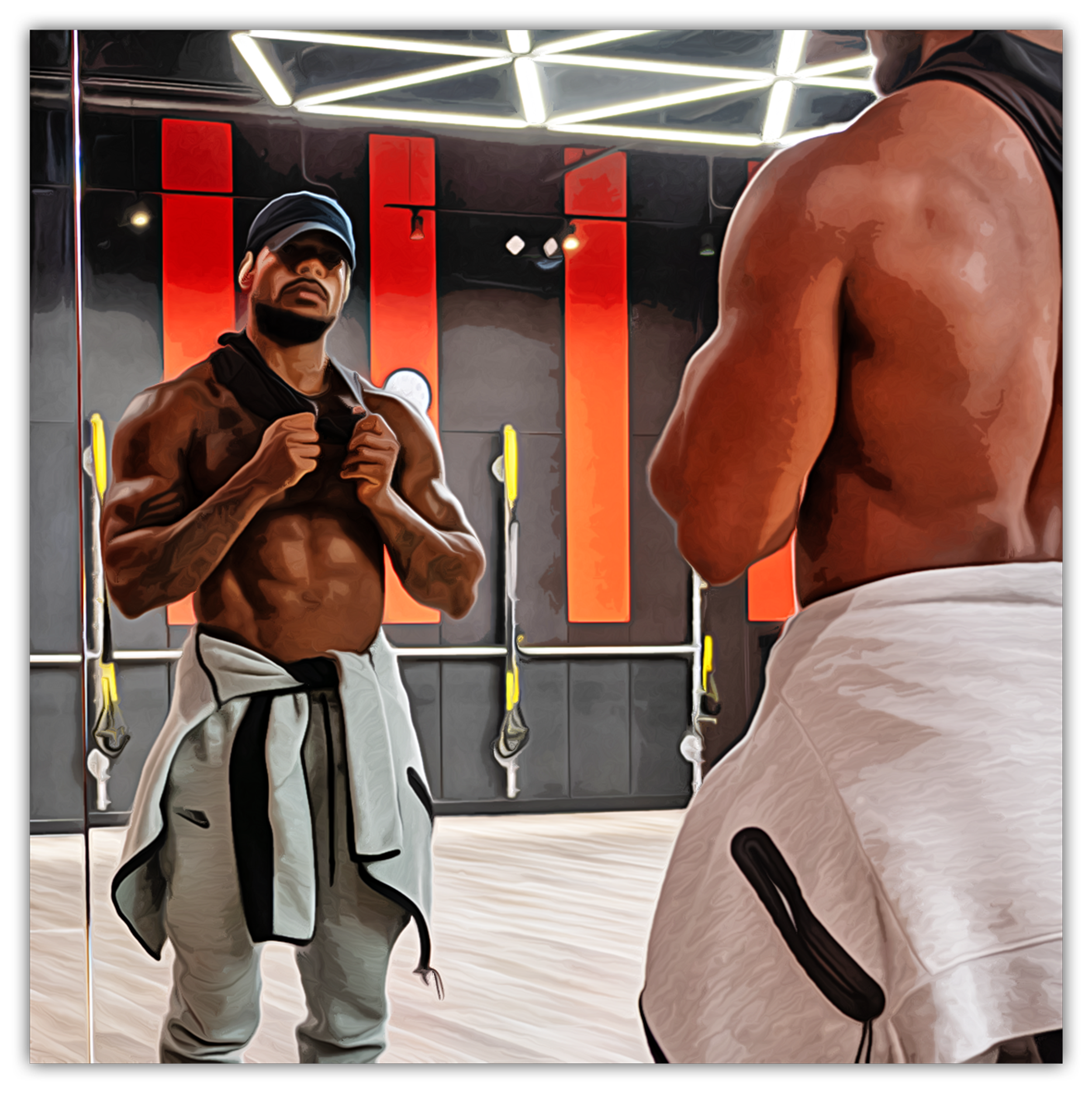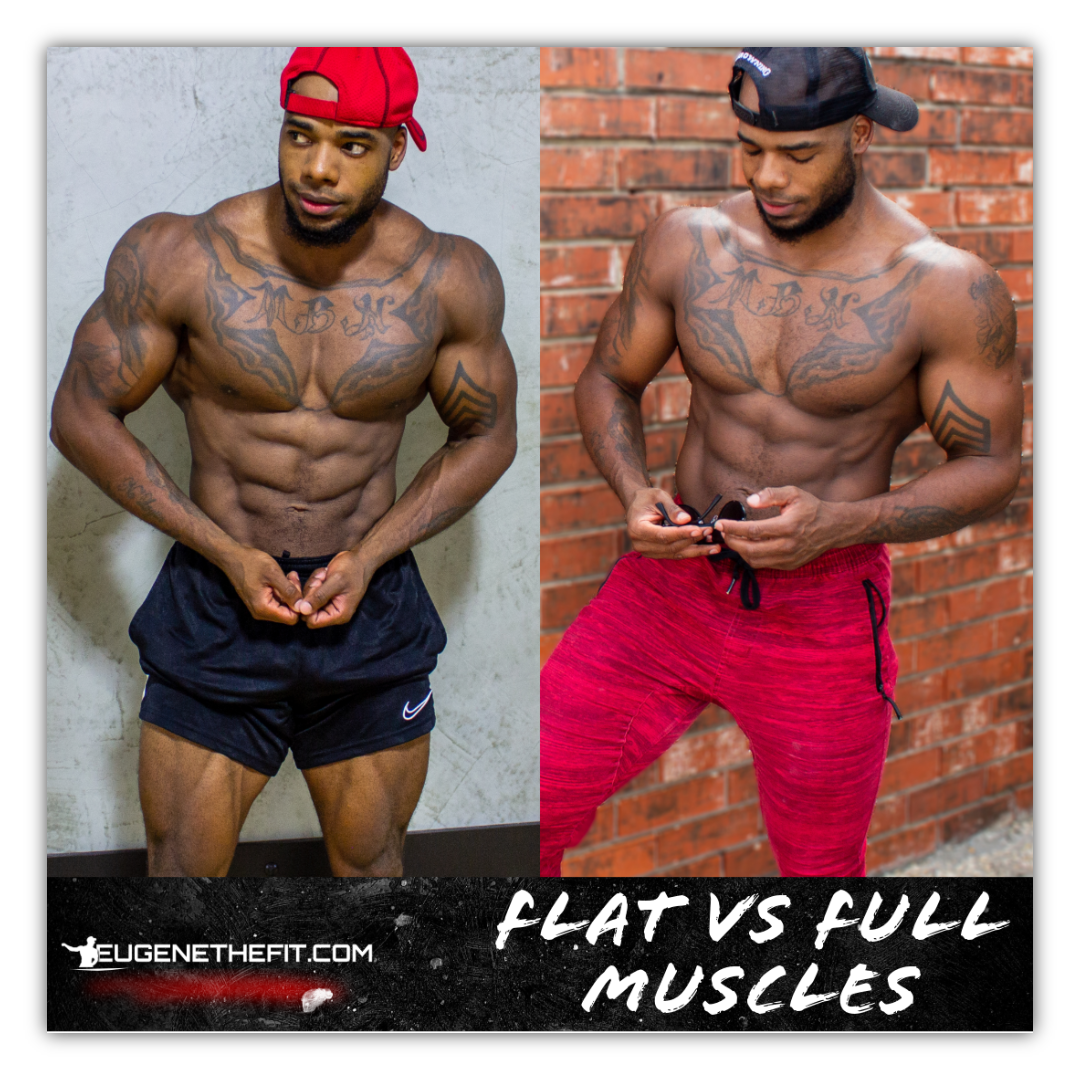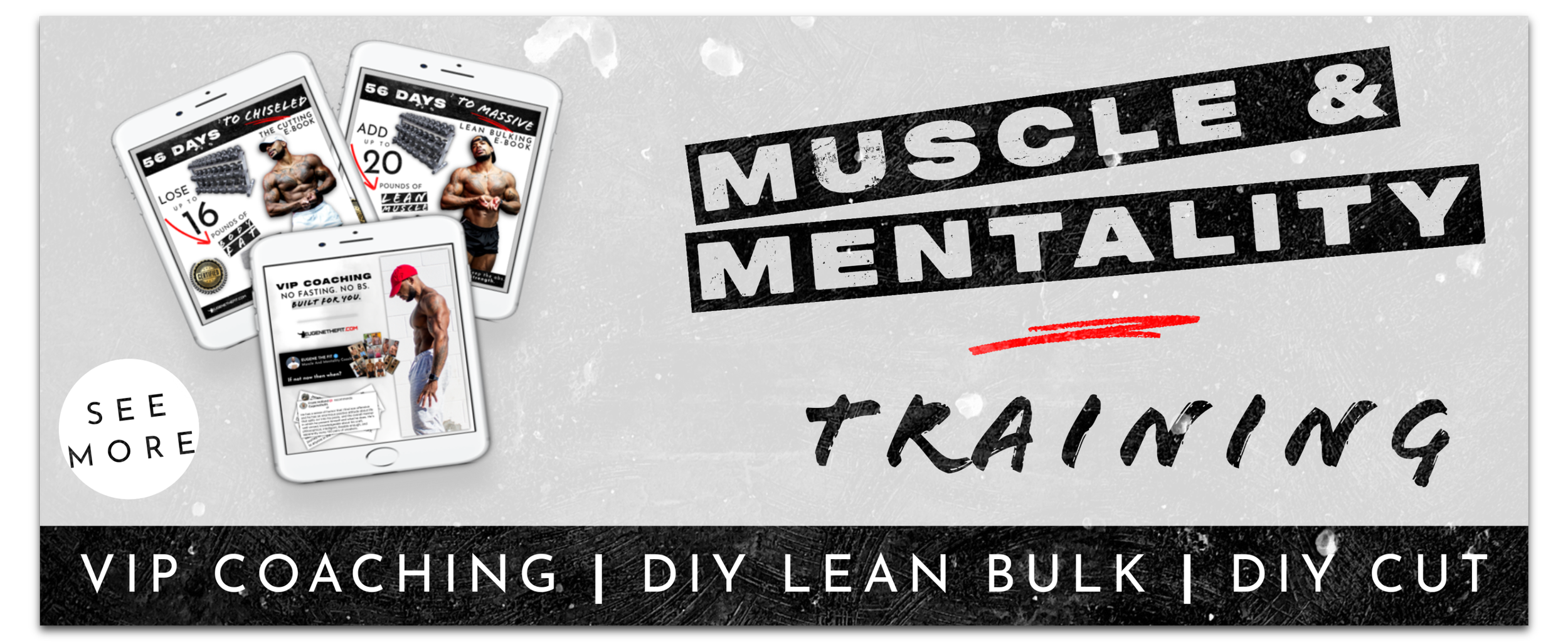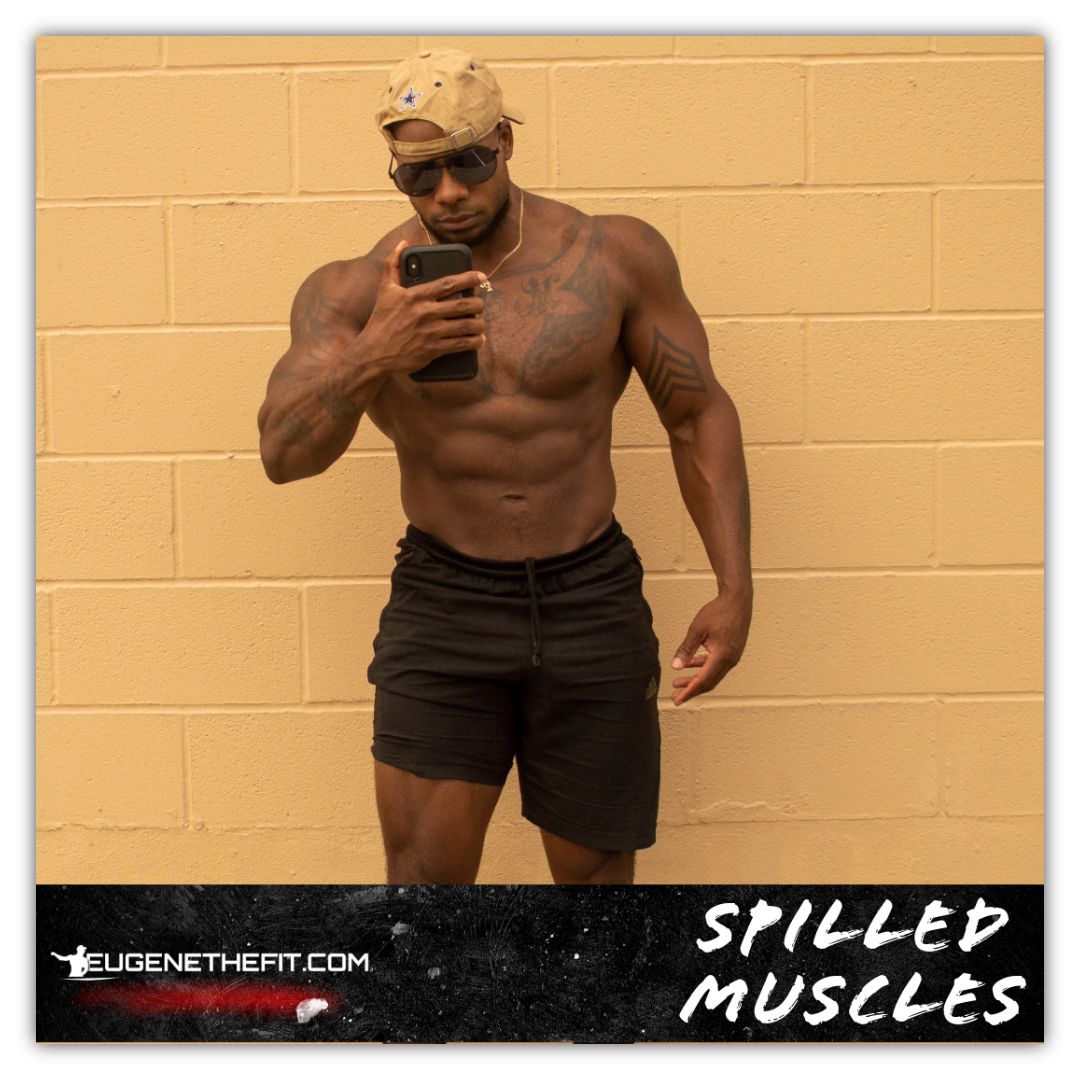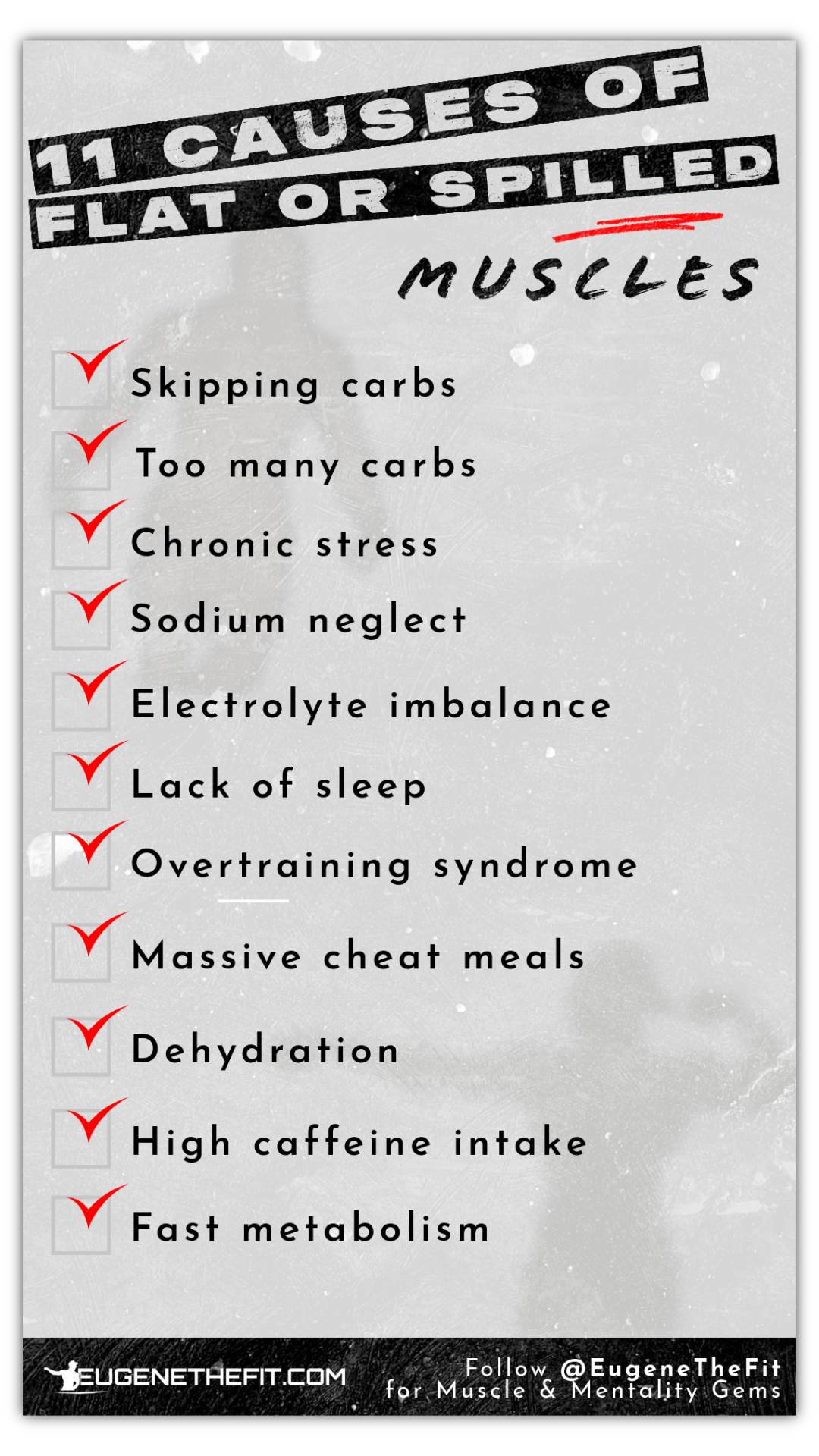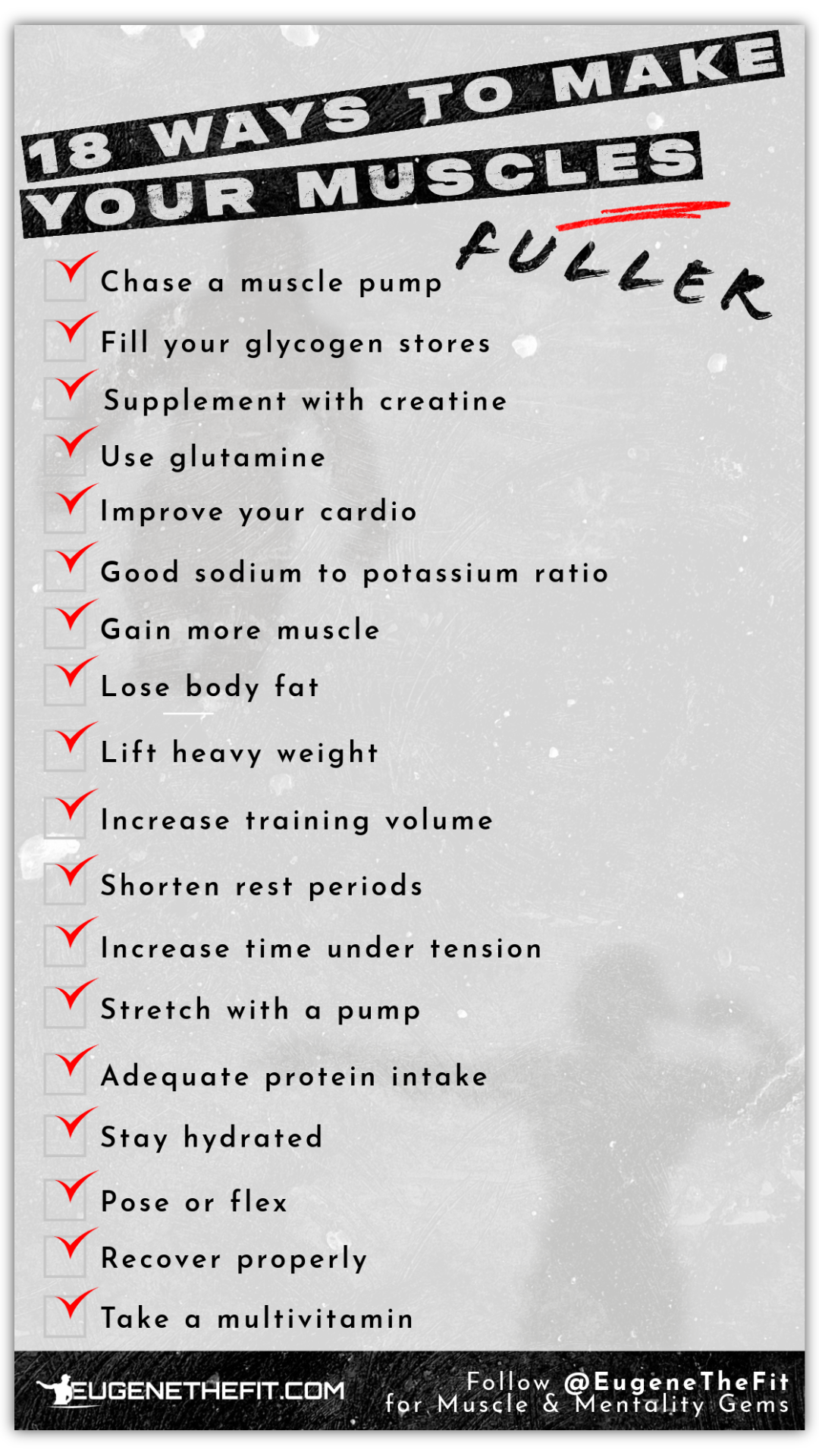How To Revitalize Flat Muscles | 18 Ways To Make Your Muscles Fuller
The often desired, yet rarely spoken about subject when considering the aesthetics of a physique: turning flat muscles to full muscles.
Ever wonder why sometimes you appear more massive than others? Same weight, same body fat percentage, but it’s as if your muscles were inflated. Like somebody connected you to a balloon pump? Your muscles are full.
Then you have the times you feel tiny. Your appearance is noticeably smaller, the muscle balloon is deflated—your muscles are flat now.
Frustrating. It’s a ping pong match and sometimes the ball rests on the wrong side of the net for too long.
But fear not. You aren’t sentenced to a lifetime of hoping you’ll wake up and go to bed with full muscles. You can manufacture that reality. Keep reading and you’ll learn just how. Even when on a cut.
In this article you’ll learn: the difference between full, flat, & spilled muscles, common causes of flat and spilled muscles, and 18 ways to make your muscles fuller.
Full Muscles VS Flat Muscles VS Spilled Muscles
We’ll kick this off with the basics. There are moderate to major differences between full muscles, flat muscles, and spilled muscles.
Yet.
Your muscles are your muscles at a particular period in time. You can’t fake what’s not there.. it’s not like you can contour your deltoids with expensive makeup and alter how the world sees them. Or artificially fluff your lats.
BUT, big but..
You CAN maximize what is there. It’s akin to having a beat up car. The car is the car, on the other hand you can keep the inside neat and the outside clean; that’ll boost it a few points. Transversely a top of the line vehicle can be knocked down a couple of notches, if there’s a mud bath on the outside and Pop Tart crumbs sprinkled across the inside.
Enough metaphors, here are the differences:
What Are Full Muscles
Alright alright so full muscles, sounds good, but what is it?
By full muscles what is meant is a physique in its full glory as currently constructed. It’s when your musculature is full of glycogen and water, also referred to as wet muscles. This state has you displaying a harder, more muscular look, often with better vascularity.
Big and tight.
If you’ve ever pondered “How to make my muscles look bigger?”, short of actual muscle growth, you in reality want to know how to make them fuller.
It’s about storing a great deal of water inside the muscle (intracellularly) and much less water outside of the muscle (extracellularly).
Why would you want this? Aesthetics of course.
It looks good, on the other hand it’s a sign of performance potential. Means you’re primed and ready to perform since the muscle is fully hydrated, with that comes greater stamina and stronger contractions.
Note: How muscular you appear still mostly comes down to how much lean muscle you carry versus how much body fat you carry. For quality size you need enough mass and low enough body fat. You can’t make appear what’s not there, but you can spice up what already exists.
Again, from a macro perspective it’s about water and glycogen storage, with that said we’ll cover some micro level methods to enhance your look even further. Keep going and we’ll have your muscles looking like they just unfastened the top button at a buffet.
What Are Flat Muscles
Your physique isn’t always living up to its aesthetic potential. You’ve worked hard, yet it looks a little eh.. a little stepped on.
Like a jolly green giant planted his foot on each and every muscle group.
Looking, well.. flat.
Flat muscles are when you aren’t holding a good amount of water and/or glycogen inside the muscle, so you have a smaller appearance.
The muscle isn’t fully hydrated. Easily identifiable because your frame looks like it was a balloon stabbed by a safety pin—like your muscles were a YouTube video on full screen, but you decided to open a text message.
The picture has been minimized.
This look can be similar to when you’re spilled or have more subcutaneous water than desired, still they are undoubtedly different.
When you go flat your physique is missing that umph. It can be quarrelsome and has led to a lot of giving up on the cut. Then you end up in the limbo of “Am I focused on building muscle or losing fat?”, exactly where a good percentage of avid lifters live.
Side Note: You can build muscle while losing body fat, but you do have to declare a major. There has to be a number one goal, otherwise you’ll run in place—this is experience talking.
But rest assured, you can cut and have your muscles looking their best more often than not. If you’re maintaining, experiencing the deflated look; solutions are here for that too. And if you’re bulking it’s less likely you’ll experience flatness, nevertheless less likely doesn’t mean you won’t, so pay attention.
The same way full muscles have performance indications, flat muscles have performance indications:
Harder to get a pump
Less vascularity
Slight decrease in body weight (of course, less water is held)
Less potent contractions
Decreased stamina
What Are Spilled Muscles
Spilled muscles, spillover, or spilling over all classify as one of those phrases that cut to the chase. Being a being comprised of mostly water, there’s always water somewhere inside (intracellular) and outside of cells (extracellular). Typically 55-65% inside and the rest residing on the outside if you want a number on it. When the extracellular number starts to grow out of proportion is when things get tricky.
The trickiness is muscle spillage.
Spilled muscles is the term since instead of retained water residing mainly on the inside, inflating the muscle; it’s in overflow on the outside, diminishing the muscle’s appearance.
Spilled muscles are akin to flat since they dwindle definition and the obvious appearance of muscular separation.
Subcutaneous water is water just beneath the skin. When you have excess subcutaneous water sloshing around, your muscles don’t get to clearly star in the show (for some reason I just pictured my toddler’s handprints on the TV).
Often referred to as smooth or soft, this largely happens because the body enjoys homeostasis.
Tampering with that will always cause a reaction.
And if you tamper the wrong way with your water, carb, and/or electrolyte intake—the body will respond. Not always necessarily a good or a bad thing, but it is a thing.
Performance side effects of spilled muscles are:
Less vascularity
Tougher to get a visible muscle pump
A softer “puffy” appearance compared to when your muscles are full
Slight weight increase
Stamina and muscle contractions are usually still up to par
11 Common Causes Of Flat Or Spilled Muscles
Now we start to dabble into the nitty gritty.
*Birdman hand rub*
Minor changes, big results. You’ll notice how minute some of the mistakes you may currently make that leads to flat or spilled muscles. But take that as a positive, easy mistake, easy fix.
Here are 11 common causes of flat or spilled muscles:
Skipping Carbs
Carbohydrates convert to glycogen (a form of glucose), we store glycogen in several places—mainly the muscles. It’s a reliable anaerobic source of energy. Within the muscle, glycogen binds with water molecules. Low on glycogen? Low on water stored within the muscles. Simple right? Well kind of—see the next point.
Result: Flat
Too Many Carbs
Going willy nilly with the carbs isn’t without backlash. Glycogen binds to water molecules, yes. You want to fill your muscles with glycogen, yes.
However..
That tank isn’t a bottomless pit. Eventually there will be overflow and all of the desired intracellular glycogen will do the deed as intended, but the rest will veer into extracellular territory. Still doing a deed, just not the deed you want, and not in the place you want it.
Your liver and your muscles store glycogen. Approximately 500 grams in fact, 100 for the liver and 400 for our precious muscles.
I repeat, what’s stored is intracellular, ready to fill the muscle up. This is where water tag teaming with glycogen is a good thing.
Glycogen stores topped off? Full muscles.
If you keep going?? The excess glucose still binds with water, but outside of the cell, creating spillage. The water balance must be maintained intracellularly and extracellularly. The game is the game.
The impact of too many carbs will make you smooth and puffy due to subcutaneous water being held.
Result: Spilled
Chronic Stress
Stress gives way to the release of excess cortisol. Cortisol is a stress hormone that is naturally excreted in reaction to physical and mental stress. The word “excess” is where we get in trouble.
A major part of overtraining syndrome is due to excess cortisol levels when your recovery methods aren’t as in depth as your training methods.
Not having physical and/or mental stress under control can lead to excessive muscle breakdown, dehydration, hindered muscle protein synthesis, slowed muscle repair, less than optimal performance, decreased testosterone, and/or subcutaneous water retention.
Result: Flat or spilled
Sodium Neglect
A sudden drop, or a consistently low amount of sodium in your diet leads to a drop in blood pressure. Think about the impact of that.
Lower blood pressure, less plasma in the blood stream. Plasma is mostly water. That’s a flat muscle if we’re considering the inside of the cell, but wait..
I have more for you.
There’s this hormone called aldosterone that regulates electrolyte balance and when you aren’t supplying the necessary amount of sodium it speaks up. Homeostasis must be maintained and aldosterone is quite the maintenance man.. or woman.
In response to a low sodium supply you start to hold any previously consumed sodium, instead of filtering per usual.
What’s held is held subcutaneously.. outside of the muscle.. spilled, smooth, a “Where did my vascularity go?” appearance.
Result: Flat or spilled
Electrolyte Imbalance
We talked about what happens when you’re too shy in the sodium department, but go ahead and adjust your lens to any electrolyte imbalance.
Particularly sodium and potassium.
Potassium is partially responsible for intracellular fluid retention. Sodium is partially responsible for extracellular fluid retention.
If your first thought is to boost your potassium and lower sodium intake.. trolly along to a second or third thought.
Aldosterone won’t go for it, and all you’ll get is unpredictable results.
The goal is normalcy, consistency—balance. More on that later.
Result: Flat or spilled
Lack Of Sleep
No sleep is another stress/cortisol contributor. Along with is stunted: muscle growth, muscle recovery, and central nervous system capabilities.
Neglecting the Zs will not only render you unfilled, it’ll have you kissing hard earned muscle tissue goodbye.
Result: Flat or spilled
Overtraining Syndrome
Overtraining syndrome is as the label suggests.. overdoing your training. But more specifically under-doing your recovery.
Overtraining syndrome is a state where your ability to recover falls short of the amount of work you put in.
Once you’re here, it’s tough sledding. There’s elevated stress/cortisol, decreased testosterone, less growth hormone, inadequate recovery, and all the lack of fullness your heart doesn’t desire.
Result: Flat or spilled
Reaction To A Massive Cheat Meal
Massive, colossal, enormous, an albatross even..
These sorts of cheat meals can throw you off the muscle fullness track. As a self-proclaimed binge eater, I can vehemently attest to this text.
The why is a combination of previously mentioned points—electrolyte imbalance and a heavy dose of carbs pushing you over the glycogen storage limit.
On the bright side, if you return to regularly scheduled programming these unwanted results won’t be around for longer than a few days.
Result: Spilled
Dehydration
If you keep it skinny on the water, you must not know the skinny on water.
*poetry snaps go here*
The body is mostly water. What do you think that means for musculature?
No matter WHAT you try if your water intake is low, none of your methods will matter when it comes to maximizing fullness. The most significant strides in the maximization process involve storing water inside the muscle.
Avoid even the slightest of dehydration at all cost.
Shortchanging water will have you thirsting for more intracellularly and/or force your body to retain water extracellularly with the belief that its host is unreliable.
Result: Flat or spilled
High Caffeine Intake
Caffeine is a diuretic.
Diuretic means it’ll send you to the bathroom to do number one, (caffeine makes you go number two too, but that’s another subject).
Urinating more frequently can cause dehydration if you fail to implement proper measures.
In addition, caffeine gives your metabolism a bit of a boost. Next we’ll talk about what a higher metabolism does.
Your water intake must go up along with caffeine intake or your muscle fullness will be out the door Jazzy Jeff style. This includes energy drinks, pre workout, coffee, soda, tea, and more.
Result: Flat or spilled
Fast metabolism
Reality is reality and some people have a higher metabolism (usually ectomorphs) than others. Gift or curse depending on your perspective.
One of the downsides when it comes to wanting to sport hard and full muscles is that your fast metabolism means a higher core temperature.
That equates to a greater chance of dehydration. And y’all know very well what dehydration does at this point.
Result: Flat or spilled
How To Make Muscles Look Fuller
Let’s skip the preamble, above everything else the two biggest conduits to muscle fullness are water intake and glycogen storage. All other factors play a role, and success in any realm is in the details, but only after the big picture is considered.
But always keep in mind: water follows solutes. In translation, wherever there’s potassium, sodium, and glycogen—H2O isn’t far behind. Whether intracellular (expanding the muscle) or extracellular (diminishing definition).
Water water water.
Got that out of the way, and we already covered defense, so you have an idea of some holes you may be able to plug. Now here are the ways to maximize muscle fullness and give off a harder aesthetic—time to score:
Chase A Muscle Pump
A muscle pump, AKA hyperemia, is when you generate extra blood flow inside those guns during a nice weight training session, emphasis on the nice.
Plainly speaking, when your muscles are bigger in the middle of the workout than when you started the workout? You have a muscle pump.
Although temporary, a muscle pump can lead to long-term size increases by potentially helping you manufacture new capillaries and by raising blood volume potential.
General training will help upgrade your vascular system [5], a pump takes it to a new level.
Fill Your Glycogen Stores
The theme of the day, adequate carb consumption gets water in your muscles making you look “harder”. Because carbs are converted to glycogen, glycogen is mostly stored in the muscle. A full muscle is a muscle full of glycogen and water.
The best time to throw down carbs is post-workout, that’s when insulin sensitivity is highest.
If on a cut you’re bound to go low carb at times, however to keep that balloon from total deflation—refeed (Major Factor In Carb Cycling).
A refeed is when you consume enough carbs to refill glycogen stores.
Do this every x amount of days (it truly is case by case). This method will help keep your muscles hard, provide fuel for lifts, and even aid in maintaining a steady metabolism if you tread into a calorie surplus on the high carb/refeed days during your cut.
Note: call back from earlier, going over your particular glycogen capacity will cause spillage, so monitor your body and find out what your max is without spill over and act accordingly.
Another note: You need potassium to store glycogen, so here’s another reason to keep your electrolyte intake steady.
Supplement With Creatine
The benefits of creatine supplementation are quite good with creatine phosphate being a natural anaerobic energy system, nonetheless it’s also stored in muscles with what? You guessed it: water.
So taking advantage of creatine’s sacred bond with water particles can give you some visible grit.
Supplement With Glutamine
Glutamine is a conditionally-essential amino acid with several functions, but happens to pull water into muscles and aids in the conversion of carbs to glycogen. That means more potential water in the muscle with even less carbohydrates.
You know what that signifies.
Improve Cardiovascular Conditioning
Cardio strengthens the heart right? That means greater general blood flow and volume with less effort [6].
Your muscles aren’t exempt from this benefit—that’s a better pump.
While weight training is priority one for your goals, a decent amount of cardio will help.. even when bulking.
I repeat, do cardio while bulking.
Consistent Sodium To Potassium Ratio
Sodium to potassium ratio is a true treasure. You need consistency, not manipulation.
The right balance will ensure more water is inside the muscle filling it up than outside the muscle, making you look like the Pillsbury Doughboy.
With a steady intake, you’ll continue to excrete excess fluid and sodium while maintaining steady blood pressure.
A good ratio for hardcore athletes is between 3:1 and 5:1 sodium: potassium. Casual gym-goers or weekend warriors are fine with a 2:3 or 2:4 ratio, particularly when heart health is a concern.
Gain More Muscle
Pack on more muscle, pretty straightforward. Not exactly a “fuller muscle” tip, still.. having more muscle will always do more for you filling out a t-shirt. Try a lean bulk.
More muscle is a guarantee to not only appear larger, but be larger.
Lose Body Fat
It’s about dimensions. By having a low amount of body fat and a decent amount of muscle you give off a more sizable appearance.
To do this, when losing fat you want to maintain as much muscle as possible. Doing so can create more definition and the illusion of greater sheer size.
Go Heavy
Intense weight lifting makes a difference. In reference to resistance training, intensity is how heavy your lifts are compared to your one rep max.
Training in the 1-6 rep range boosts anabolic hormones such as testosterone, growth hormone, and insulin-like growth factor (IGF-1) to a greater degree than less intense lifts, yet all weight training has an impact.
Sprinkle in a bit of heavy along with your hypertrophy-focused moves to kick up hormonal activity.
Train With More Volume
In weight training circles volume is a reference to the amount of sets you knock out in a session for a particular muscle group.
So, weight training uses glycogen as one of its go to energy sources right? Right. Added volume means additional glycogen being used.
Glycogen-depleting workouts lead to overcompensation when you do happen to consume carbs, by storing more glycogen than before [7]. Up to a 20% increase.
Short-term overcompensation means a fuller muscle, but not only that—long-term your body will develop the capacity to store more glycogen even in the absence of supercompensation.
Try Shorter Rest Periods
Extended rest periods between sets is good for recovering and allowing you to handle more resistance per rep.
But.
This is certainly the enemy of a pump and isn’t the most efficient way to build muscle (sorry powerlifters).
Condensed rest aids the blood flow gains of a pump. To pile on it creates one in the first place, being that you don’t give your body a chance to move that extra blood out of the targeted muscle.
Too long between sets and that excess blood flow is out the door.
Try limiting your rest periods to 30-60 seconds between sets for a better chance at keeping blood volume up.
More Time Under Tension
Personally I’m not the biggest advocate for exclusive high rep, time under tension focused training. Unless you’re dealing with some sort of injury of course, however..
A good pump-inducing muscle-taxing burnout set before changing muscle groups can give you more walk-around size. I’m a big fan of taking my muscles past failure with a solid finisher set, after my final working set for a particular group.
Make some of your sets, especially the last set, go for 60+ seconds of straight tension and over time you’ll be glad you did.
Time under tension is how long your muscles are under load. These long sets cut off circulation to working muscles.
The continuous contraction leaves blood outside waiting to get in. When the set ends it’s like a ribbon cutting ceremony for your vascular system.. the crowd is so eager to get in that maaad blood flow rushes through the door as soon as you stop.
Progressively, continued pumps and the outward pressure they produce will stretch muscle fascia.
Stretch While Pumped
Once you finish targeting a muscle group for that day, stretch the muscle group for 30-60 seconds.
According to the Journal of Applied Physiology this may lay the foundation for new muscle fibers and piggybacks on the outward pressure your blood flow provides while pumped [8].
In time you’ll see the effects.
Keep your Protein Intake Up
This point is more about long-term muscle growth and retention than anything else. You need amino acids to maintain and build muscle—without them, no matter how you try, those muscles are bound to deflate & disintegrate.
0.7-1.8 grams of protein per pound per day has worked well for world-class athletes.
Get your munch on.
Stay Hydrated
I say again, water makes muscles full and hard. You have to avoid dehydration: protein, creatine, glutamine, carbs, caffeine, and stress heighten your hydration needs.
Posing/Flexing
Your knee-jerk reaction may be ”I don’t compete and don’t plan on competing”, but bear with me.
Competitor or not, holding a flex for each muscle group outside of your standard resistance training sessions will enhance blood flow.
It won’t build much muscle on its own, but a few times per week set aside a solid amount of time to lock in mentally and hold an aggressive contraction for every muscle group.
Need more incentive? Not only does flexing/posing enhance blood flow, it’s contraction practice. It’s not enough to just master the pattern of movement when lifting, you want to master contracting targeted muscles during the pattern of movement. It recruits more muscle fibers.
That bolsters training sessions and therefore the building of muscle. To have quality contractions, you need a quality mind-muscle connection.
Mind-muscle connection is your ability to effectively use a specific muscle or group of muscles to move a load.
It’s you being able to “think” the muscle; to become one with the muscle, if you will.
The better your contractions, the better your connection, the better your growth, the better your ability to burn calories. So get familiar with how to contract your muscles on command, initially you won’t have much of a clue on how to isolate a specific muscle, but over time with concerted effort you’ll develop a connection across the board.
Note: Another way to get this effect is by flexing between sets. It’s extra practice and makes way for an even better pump.
Recover From Lifts
Muscle grows during the recovery.
You tear muscle tissue via training and the tissue repairs better equipped to handle a similar stimulus in the future if precautions are taken.
This maximizes hypertrophy potential and your potential for muscle fullness. Otherwise you’ll eventually dip your toe in the overtraining syndrome water and welcome all of the hormonal pitfalls that comes with that.
Multivitamin
Sufficient water consumption is a go for maximizing muscle fullness and growth, but it has potential side effects.
Particularly if you don’t use the best source for your situation, the reason I’m about to mention is part of why I recommended spring water for most scenarios.
You risk prematurely flushing minerals out of your system. To help combat this potential, supplement with a multivitamin.
As stated many times, glycogen storage is the most important aspect of muscle fullness, then there’s your sodium to potassium ratio, on the other side other minerals have something to say about where you hold water as well—just to a lesser degree.
MY THOUGHTS
A concern with muscle fullness is usually about competitions or photoshoots or social media posting, but I don’t know an everyday lifter that wouldn’t like to maintain fullness.
Don’t get too caught up or stressed if you have a day or so in the flat arena, especially when cutting. It doesn’t mean your gains are gone, trust me. If you’re cutting steadily and correctly they’re still there. Just follow these tips and you’ll be full more often than not. And you’ll know how to fix any lack of fullness.
Trying to trick your body or not enough consistency can lead to water decreases inside and possible increases outside the muscle. If you’re getting ready for the stage you may dabble in trickery a bit (as of now I have no stage experience, so consult with those with a ton of it if you’re working on peaking), but that seems like quite the risk not knowing how the body may respond. Consistency is more predictable.
Another possible fullness tip.. did a lot of scouring and this is probably a little too nuanced to have a study available, but I take a daily walk just to get sunshine and at least 20 minutes of outdoor activity each day. When the Sun is out I take my walk shirtless to soak up extra vitamin d, right from the source. I’ve noticed something year after year. During spring and summer, when the Sun is in full glory, my muscles are fuller than any other time. Could be in my head, could be testosterone related, or some other factor I haven’t considered. I’d feel like I cheated you if I left that out.
Alright Fellow Now Full Muscle Havers, IT’S ABOUT THAT TIME
We came, we saw, and we conquered flat muscles. We made way for full muscles AKA when your muscles are filled up with glycogen and water. This creates a harder, tighter, more muscular appearance.
If dieting down you’re bound to go flat at times, it’s part of depriving your body of its desired amount of energy. Still, maximize what you have and keep growing.. the process is a beautiful one. Embrace the challenges.
Subscribe to stay updated on new posts and share this with someone that could also benefit from fuller muscles. Time to go fill those muscles up and Be Great.
SOURCES:
[2] Bodybuilding: The Complete Contest Preparation Handbook By Peter Fitschen And Cliff Wilson
[3] Bodybuilding.Com/Fun/Drjoe12.Htm
[4] Bodybuilding.Com/Fun/Drjoe13.Htm
[5] pubmed.ncbi.nlm.nih.gov/15333630/
[6] pubmed.ncbi.nlm.nih.gov/17630597/
[7] ncbi.nlm.nih.gov/pmc/articles/PMC3379704/
[8] journals.physiology.org/doi/abs/10.1152/jappl.1993.75.3.1263

